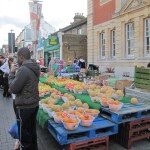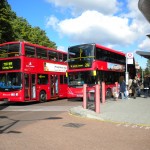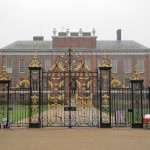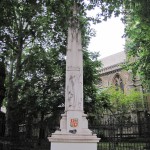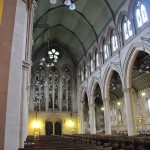Entries Tagged as '2010 Stephenie'
September 7th, 2010 · 1 Comment
… So far.
During the two weeks in London, I have so far had the opportunity to see a variety of shows, which have offered different perspectives of theatre culture in England.
First, there was The Merry Wives of Windsor at The Globe. As a groundling after a long day exploring the city, my feet were exhausted by my excitement levels were through the sky (well, higher than usual, as they tend to be at somewhat extreme heights in general). Seeing Shakespeare performed at The Globe was an incredible experience for many reasons. Not only was the performance one of the best live productions that I have seen, the theatre’s atmosphere was almost indescribable. It was almost if everyone had traveled to the turn of the 17th century. Usually, everyone is quiet during the performance and politely respectful of the performers. While this was the case, the audience seemed more willing to shout, cheer, and laugh uncontrollably at the events on stage. Being so close to the stage, the magic of the actors radiated from the stage and created an atmosphere unmatched by any performance thus far. The added music also added to the atmosphere- an Early Modern theatrical experience would have had the pre-show performers and would have been completely different from what we are used to. The performance was as close to replicating that experience as possible in our modern world. Afterwards, we were able to thank some of the actors and they seemed sincerely grateful that we said something- an idea that would be challenged later.

Next came the Proms at Royal Albert Hall. While The Globe was magical, Proms was one of the most equalizing of the performances because of how accessible they were. In the States, every classical concert I have been to has been a stuffy affair. There, the celebration of the music was open and everyone seemed to be unified in their desire for good music (which the audience should not have been disappointed with). The biggest issue I had with the Proms was the incessant coughing. Usually people try to hold their coughs, but when one or two people cough at during movements, it doesn’t provide an excuse for everyone to cough uncontrollably to prove they can and that they are not going to do disrespect the musicians by coughing during the performance. I would like to go back to Proms to see if it is a bizarre tradition or if that night was a fluke.
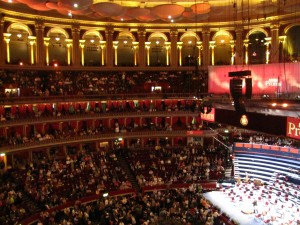
Royal Albert Hall
My following experience was Billy Elliot, which I have already blogged about, so I’ll try not to be redundant here. Other than being my first big West End experience, it was also important because it showed a lot of the themes of our course in a new light. Instead of applying the themes to the immigrant communities, it showed the themes in terms of a distinctively native English story. Furthermore, it also highlighted two differences between English and American theatre in particular. Firstly, we aren’t used to paying for our programs in the States. As an avid theatre goer, I’m used to being handed a Playbill (or regional equivalent) and continuing into the theatre. I don’t have to wonder who the cute guy playing a certain character is or why so and so looks so familiar. I don’t mind paying an extra three quid when I’m paying half of what I’m used to paying, but it definitely caught me off guard. Secondly, the tradition of stage door here is (as far as I’ve gathered) practically non-existent. In NYC, it is fairly common to wait after the show at the stage door to thank the actors for their performance, get an autograph, and if you are lucky, a photograph. (Yes, this can be a weird experience, but it can also be a great one.) When we went after Billy, it was completely different. While there were people there, the actors went by ignoring everyone. After Holly mentioned it, I realized that this was indeed a representation of the English concern for privacy and social dis-ease. On stage, the actors are free from interacting with the strangers feet away from them. At the door, they are in a different type of spotlight. Yet, the boundaries between personal and private life would not intersect. They are still technically at work. The guys from The Globe seemed to enjoy that we acknowledged them. I can’t wait to try another stage door experience to see the difference. (I planned to try again after Les Mis, but it was raining…)

The Victoria Palace, Home of Billy Elliot
Next came Bedlam, back at The Globe. For the first play by a woman performed there, the show was interesting. I’d like to say it succeeded it my expectations (which weren’t that high), but it didn’t. It did meet them, but something about the show was lacking the magic of the first show we saw there. At the end of the first act, I wasn’t at all satisfied, but by the end of the second, it had redeemed itself. I’d like to blame this all on not being a groundling and therefore surrounded by the audience members and the actors. I did enjoy it but it was not my favorite by any stretch.

The Globe, A View From Above
Lastly (thus far) is Les Miserables. One of my favorite musicals, I thoroughly enjoyed it. Despite the fact Marius has a slight bald patch, the actors were outstanding. (Even Norm Lewis, who I have seen in another musical and was THOROUGHLY disappointed in then, was outstanding. His awkward- but commanding- stage presence was perfect for Javert.) A truly equalizing musical, I was not surprised to see people in blue jeans and others in formal dresses. The difference is interesting when considered in the context of the musical and its equalizing themes. Theatre in London is truly for everyone- no matter one’s status. Seeing the opposites in dress at this show hit me as strangely appropriate. (I don’t want to elaborate knowing that some of you guys have yet to see it. So, I’ll just leave it at that.)
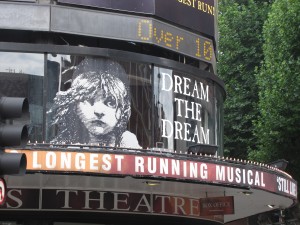
So far, I’ve thoroughly enjoyed my experiences at the theatre and can’t wait for more. I’m hoping to see Wicked (my favorite, in case you have missed that slight detail) and Blood Brothers at the very least. While technically not theatrical, I also expect my experiences at the various football matches I’m planning on going to to be worthy of a theatre stage!

Tags: 2010 Stephenie · Theatre
September 3rd, 2010 · 5 Comments
As someone who wants to work at a museum, I enjoy different ones (even on a day where I visit four) and seeing how they formulate their exhibitions and present their collection. I also enjoy seeing how children interact with museums, as I want to combine museum education with my love of medieval art. The National Portrait Gallery, however, was not the best museum I have been to thus far. In fact, the quality of the art aside, I was largely disappointed.
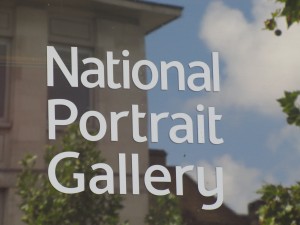
Going in, I expected the portraits to be largely of the elite ruling class and others who had some power, whether political, artistic, or scientific. The collection was predominantly white elites (mainly males). This is understandable, as that was who was most likely to be in a position of power through the majority of England’s history. While portraits are not as readily available of the lower classes, they do exist. The NPG seemed to overlook this fact until very recent history. (Even then, the portraits chosen to be featured in the permanent collection tended to have an element of celebrity rather than being chosen for the lesson they can teach about daily life in a given period.) After finishing the Tudor section, my interest levels were in automatic decline and the museum had very little to reverse that. Its one redeemable feature was the interactive computer stations that went past the simple didactics in the collection. Yet, even that was lacking: it was written for an average adult.
There should have been a version of the interactive stations specifically designed (and easily accessible) for children. (Supposedly there was a map for children, but I did not see any families with one. Did anyone??) The NPG is a family destination: tourists (who make up a presumably large part of the museum’s audience) do take their children there (I witnessed several families) and there needs to be something more that acknowledges this more interwoven into the permanent collections. Instead of a dad timing his son to see how long he could walk from one end of a wall-long portrait to the other, I should have witnessed a dad engaging his son with a museum map for children. (This is something that I have seen in almost every other museum on this trip, which made the issue more obvious to me. If a family chose not to use the available map, then the museum still has the responsibility to help engage a wider audience.)
One of the few portraits that spoke (amidst the celebrity portraits) to me was a small model of a full-scale statue of Albert Ball by Henry Poole. Ball, a WWI pilot, shot down 43 enemy planes before being killed in action. At 21, he is one of the few people who appeals to a largely universal audience: English viewers for his patriotism, history buffs (WWI geeks specifically), art historians for his glimpse into war-era art, younger children of all backgrounds because of his heroic story (everyone loves a good hero, yeah?), 20-somethings who wonder if they can make a difference, and wanderers because of the persona that radiates from the work itself, capturing the power and passion of a young hero. Yet, even the portrait I liked the most stuck true to the NPG’s “requirements” for display: white and elite. (The portrait was given by Ball’s father, Sir Albert Ball). It did, however, lower the average age of the collection’s sitters by a few years… Picking a younger sitter for a comic book-esque family guide would have engaged the children. Who better than a WWI hero to be the leader? (This could easily be inserted in the visit with a small map and identifying pictures on didactic panels to let families know that a certain portrait would be more interesting for a younger audience.)
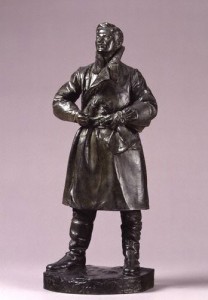
Albert Ball by Henry Poole, 1920s, http://www.npg.org.uk/collections/search/portrait.php?locid=50&page=1&rNo=6
After visiting the NPG’s education website (http://www.npg.org.uk/learning.php), I realize that there are educational activities available for families; I do want to give them some credit. However, I wish there were more in the gallery on a daily basis rather than on weekends or just for school groups.
To recap. The negatives: a lack of engaging material (even the interactive bits got boring after a short while, and specifically for the younger members of the audience) and a less than diverse “cast” of sitters. The positives: the collection itself (overall stellar artworks) and the opportunity to think up some (hopefully) creative activities that if I were the Curator of Education I would consider adopting. (Who knows? Maybe I will borrow these from myself in the future at an internship…) Oh, one other thing, what was up with the atrocious color scheme in the Regency wing? It detracted from the experience for me because there were times I noticed the wall color before the portraits, which should never happen, especially at a major national institution!
Tags: 2010 Stephenie
The Notting Hill Carnival was not what I expected, but at the same time did meet some of my expectations. The ones it met: the drinking/party atmosphere (it also exceeded this one by a lot) and excellent food. The parade disappointed me; I was expecting more cultural representation and differentiation. Instead, I found it to be lacking. My initial reaction was, “Okay. This is different, but cool.” By the third “float,” however, I found them to redundant. The costumes were gorgeous, but some of the marchers should have rethought their costume decisions. Coming from a family that loves parades- we watch every Thanksgiving Day & Rose Bowl parade together- I was expecting different floats, all intricately designed and reflective of the culture of the community who put that float together. Instead, it was mostly people in sequined and glittery costumes walking behind a big truck (or double decker bus) that was playing loud music- some of which was American. I was hoping for a cultural learning experience, not a chaotic drinking party in the middle of the day posing as a cultural experience. Setting aside the drunkard-dodging and remixed American music, I enjoyed the carnival for the experience it offered; it was definitely a chance to observe the English in what Fox referred to as a “liminal” space. In different ways, I felt that people were more relaxed and open to just enjoying the experience. The typical English reserve seemed to be greatly diminished (among the sober and definitely not sober). It was a great overall experience, but I don’t think I would go to the Carnival in the future.
-
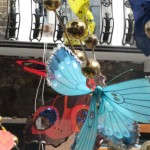
-
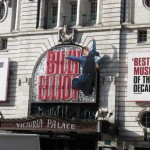
Billy Elliot, however, exceeded all of my expectations. It is something I wanted to see while I was here, but I never expected it to tie Wicked for my favourite musical. (Note: I’m a bit obsessed with Wicked. You probably don’t want to mention it in a 10 foot radius of me if you don’t want to get into a lengthy discussion.) About a young boy who discovers that he is a talented dancer and decides he wants to dance for life, the story concentrates on several of the topics we have (or will) discuss will discuss in class, including labor strikes, class, and the government. Throughout the entire musical, class is an issue. For the miners in Billy’s community, dancing isn’t something done. A male dancer is a “poof” not to be taken seriously. A career as a miner and providing a steady income for one’s family is the most respectable option. Billy’s dad is dead set against Billy dancing, but when he realizes he is so talented and can’t help but dance, he decides to go back to work in the mines. (They’ve been in the middle of a mining strike.) Breaking the strike drives a wedge between him and his older son, Tony. The representation of community in the musical, especially among the miners despite their hardship, is an excellent example of the way our readings have mentioned communities coming together. Furthermore, seeing this community on throughout their strike adds a human dimension that our readings could not express. It brought the stats to life for me, which is something that I normally look to art to do. The musical also touches on Thatcher’s government & the way that it reacted to the strike to break it. (“Merry Christmas Maggie Thatcher” had to be one of the most hilarious and poignant scenes in the entire musical, giving an excellent representation of how elitist that government seemed.) I could go on forever on the way that it relates to class. It’s an excellent musical that I think everyone should see. There is something for everyone in it, especially as we all consider the diversity of London, the struggles of labor, and the English class system.
Tags: 2010 Stephenie
Our morning started out great: a nice breakfast, an exciting market to explore, and a seemingly easy route to the Walthamstow market. Upon arriving at the Warren St station, we discovered that the Victoria line, crucial to arrive at Walthamstow market, was closed for engineering. We had been warned that we might want to check to see if all of the lines were working as usual over the weekend… However, we all took that as a “make sure you know where you are going” warning rather than a “look up the closed lines online before you leave” instruction. Oops. Once we figured out how to get to Walthamstow (Central line to Liverpool Street Station to catch the National Rail up to Walthamstow Central), it was a breeze. An hour’s worth of breeze, in fact. Once there, we quickly located the market, which was about a block away from the station.
Our destination, Walthamstow market, had a wonderful selection of fruits, vegetables, clothes, pots and pans, handbags, toys, lace, material, and other random items- all very reasonably priced. People arrived with empty bags with wheels to carry their shopping home. (One lady complained to a friend that she had bought too much and her husband was going to fuss at her.)
It was a very demographically diverse area, we saw people from various countries in Africa, Eastern Europe, the Middle East, and India. In the couple of hours we were there, we heard at least ten different languages. The vendors themselves were predominantly English or from the Middle East. When walking around the community, we noticed a multicultural center, giving us the impression that the community was aware of its diversity and more than likely sought a way to embrace it. Around the market were more specialized stores, which included fabric stores, grocery stores, candy stores, a Pound Power store (everything was a pound; equivalent to the American 99₵ store), and most importantly, a variety of cultural restaurants.
On our way back to the Arran House, we decided to be just a bit more touristy and take a double-decker bus to see more of the area and London itself. Seemingly great idea, but like this morning, it became a hugely complicated decision by a number of factors. Firstly, we weren’t sure what route to take because we were unsure of where in England they would take us. Secondly, when we did decide what route would be the easiest, we were unaware that the bus station we were at contained two other platforms; therefore we assumed the bus that would be the easiest to get back to the house did not stop where we were. After waiting for an alternate bus, only to watch it get full and drive off, we discovered our original bus did stop there- just further up the street! We ended up taking the 48 bus to Liverpool St station, catching the Central Line to Tottenham Court Rd and transferring to the Northern Line to Goodge St. Can you say HOME SWEET HOME?
For more info: http://www.walthamforest.gov.uk/index/environment/walthamstow-market.htm
[kml_flashembed movie="http://www.youtube.com/v/nvHDEVwQrjY" width="425" height="350" wmode="transparent" /]
Video on YouTube
Tags: 2010 Jamie · 2010 MatthewM · 2010 Stephenie
August 26th, 2010 · 1 Comment
This afternoon, we saw more of London than we bargained for. Our goal for the assignment was to visit the Kensington High Street (KHS) Tube stop; our navigational skills are clearly wanting at this stage in the game, as an 8 mile round trip took nearly two hours. The following is a recap of our jet-lagged travels.
We managed to go the wrong way out of the front door of the Arran House, as our goal was to take the Circle Line from the Euston Square stop to the KHS one. A genius plan, as we could cover the requirement to take a different route there and back by circumnavigating the Circle in opposite directions. Alas, that would have required making a left out of the Arran House. We made a right. We ended up stumbling on to the Tube at Tottenham Court Road, which could have been an only slightly shorter Tube trip. Fortunately, construction at the Bank stop thwarted our plans, and we took the Central Line all the way out to Liverpool Street before finally connecting to the Circle. Conservatively, this foray took 40 minutes. We took the simpler (and quicker) return path of the Circle back to Euston Square.
Unless it is indeed not as obvious as we think, the KHS station is named for the nearby Kensington Palace and Gardens. The Tube presumably stops there because the surrounding area is an upper class shopping district. The American supermarket Whole Foods, typically found in wealthier locales in the states, had a massive store right down the street from our stop. It is located in the Royal Borough of Kensington and Chelsea.
On our way to Kensington Palace, we stumbled upon a war monument dedicated to the men from Kensington who died in “The Great War.” The monument was situated just outside of an old church, St. Mary Abbotts. St. Mary is a Victorian building in the English Gothic revival style. (A church has been on that site since the 9th century.) Leaving, we got directions (albeit quite circuitous ones) to the palace from a church attendant. Our time was cut short in exploring the area around the palace and its gardens because of the rain. However, we did stumble upon the Romanian Embassy.
Who was on the street? Well, in our brief and informal survey of the neighborhood, there were a lot of pigeons, haughty rich people, tourists, and improbably, two policemen armed with automatic weapons and sidearms. (They followed us for almost two blocks). The area of the neighborhood that we walked in was largely a upper-middle-class shopping district; residences were not readily noticeable. The architecture was an eclectic mix of what appeared to be Victorian-era buildings and more modern stereotypical shopping centers.
Overall, it was quite an enjoyable adventure, despite the rain and the initial issues with the Tube.
Tags: 2010 Dennis · 2010 Stephenie











